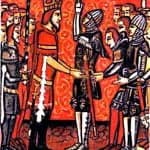Medieval Era Fashion Medieval Era Vassals Clothing
Medieval Vassal
During the medieval period, kings ruled large areas of country. In order to protect these lands from invasion, the king would requite portions of their lands to the local lords which were called the Vassals. They governed the lands granted to them by the male monarch and promised to defend it against conquerors.



Medieval Vassals Definition
The Medieval name "vassals" was believed to have been derived from the Latin word vassallus and the Roman word vassus, which meant servant. However, it was also said to take originated from the Celtic and Welsh term gwas which meant a young male feudal tenant.
In the feudal system, Medieval Vassals by definition were people granted the utilize of a King's country in render for their services, which included homage, fealty and military services equivalent to that of a lord. Vassals can also be referred to as "feudal tenants".
Medieval vassals were complimentary men given authority to handle some of the King's or the Lords estates, which were called a fief. The term vassal originally emerged during the medieval era of the centre ages as the feudal system was established in England in 1066 later the rest of the country was usurped by William, The Conqueror.

This image shows the position of importance of medieval vassals in the feudal system
Medieval Vassals History
The outset vassals during the medieval flow came from England and were appointed correct later the Norman Conquest. When William the Conqueror invaded the land, all estates that belonged to England were declared as his holding. And to requite award to the Normal soldiers who fought with him during the conquest, he awarded the bulk of the lands to them. After William gained command, the Norman soldier who became and were declared Lords of these lands began to rule with him. Noble men became Lords and lower military machine officers became vassals. The thought of application the lands to the Lords basically was to assist the new ruler in protecting the kingdom from invasion as each Lord was in-charged of protecting his ain country.
The Medieval Vassals Land
The medieval vassal lands varied in size. The average size of these land, known equally fief, were as modest as 1200 acres and as big as 1800 acres. Most of the feudal lands consisted of farm and cultural lands. Meanwhile, the vassals either lived in castles of the lords or they owned their own manor. Bated from farm and cultural lands, medieval vassal lands would typically accept forested areas, pasture lands, villages, mills and churches, depending on the size of the estate. Most importantly, information technology would include a Manor House. In most cases, the Manor Business firm served as a residence for the Lord or Vassal and his family. The estate house ideally would be built apart from the villages where peasants and other workers lived.

Sometimes several medieval Vassals were chosen upon to run across the king for important business
Medieval Vassals Duties in the Feudal System
In the feudal system, medieval vassals were expected to perform certain duties, render services in exchange for the fiefs that were awarded to them. Primarily, vassals were considered second in command to whomever directs the estate, be it a Lord or the Rex.1 of the primary duties of medieval vassals during the middle ages was to keep the manor and watch over the daily activities within the manor. They were as well more powerful than other workers in the estate such every bit the peasants. They usually had privileges which included judicial rights.
Amidst other duties, a medieval vassals was required to attend to the feudal lord specially during court. It was his responsibleness as well to recruit men for armed forces duties. It was also his duty to supervise the peasants, serfs and other workers who lived in the manor estate. He was the mercenary of the feudal lord.
A Vassals place in the Feudal Organisation
Bullwork was based primarily on the commutation of land for military services. Medieval vassals were required to pay allegiance to the King or the Lords, and everyone was expected to pay for the lands by providing services that included completing chores from the lord, training soldiers to fight and preparing them for battle, and providing weapons and other supplies for medieval soldiers.
However, nigh vassals during the medieval era functioned as both vassal and lord. This only meant that they were vassals to a lord just had the ability to lease the land to other lower class vassals. This kind of setup was very common among nobles during this menstruation since this served every bit means for them to earn money.

The Male monarch and Vassals relationship inside the feudal system that dominated medieval gild
The Vassals relationship with the Lord
Vassals and Lords usually shared common loyalty. In most cases, medieval vassals served the lords and fought in battles forth with the lord. Since information technology was i of his core responsibilities to train men to fight and prepare them for battle, the vassal's men nigh likely would levy the lord in times of war. In some rare cases depending on his rank, he may also have been tasked to train the lord's son to get a knight. In turn, the lord had to reward the vassal's loyalty to him. With this, the lord provide additional lands, money or even give gifts and granted certain privileges to the vassal.
In the medieval era, a chivalric organization applied among noble classes, including the lords. Even if the vassals owed the lords, the vassal and his family all the same deserved the lord's protection.
Summary of a Medieval Vassal
Feudalism was a combination of customs both legal and war machine that flourished during the medieval period specifically betwixt the ninth and 15th century. This was considered the arrangement that structured social club during the middle ages, where relationships were chiefly sprang from trading lands for services. Medieval vassals were bounded by mutual obligation to lord or rex in the context of feudalism. These obligations included but were non only limited to military machine services and communal protection. In exchange, vassals were granted lands in the form of fiefs and were given certain privileges to manage the manors or estates.
The vassal-lord human relationship was founded on loyalty and common commitment. Vassals committed to performing their duties and responsibilities to the lord, while the lord granted him lands, protection and privileges.

A medieval Vassal is on important business organisation meeting with the medieval king
This bail was farther strengthened every bit medieval vassals were field of study to an oath called Fealty, which derived from the Latin word Fidelitas that meant fidelity. This oath was taken during the commendation ceremony and aimed to outline and strictly impose a vassal's dedication and delivery to the lord.



0 Response to "Medieval Era Fashion Medieval Era Vassals Clothing"
Post a Comment